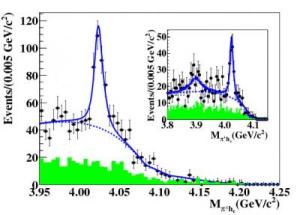Nov 11 2013
An international team of high-energy physicists says the discovery of an electrically charged subatomic particle called Zc(4020) is a sign that they have begun to unveil a whole new family of four-quark objects.
 The peak is evidence for Zc(4020) decaying to ð±hC. Credit: BESIII Collaboration
The peak is evidence for Zc(4020) decaying to ð±hC. Credit: BESIII Collaboration
The Beijing Spectrometer (BESIII) collaboration, which includes scientists from the University of Hawaii at Manoa, previously announced the discovery of a mysterious four-quark particle called Zc(3900) in April 2013.
"While quarks have long been known to bind together in groups of twos or threes, these new results seem to be quickly opening the door to a previously elusive type of four-quark matter," said Frederick Harris, a professor of physics and astronomy at UH Mānoa, and a spokesman for the BESIII experiment. "The unique data sample collected by the BESIII collaboration has continued to yield a stream of clues about the nature of multi-quark objects."
The recent breakthroughs by the BESIII collaboration have come about through a dedicated study of the byproducts of the anomalous Y(4260) particle.
Using the Beijing Electron Positron Collider (BEPCII) in China, scientists tuned the energy at which electrons and positrons annihilate matter to 4260 MeV, which corresponds to the mass of the Y(4260) particle. The BESIII Collaboration used this method to directly produce and collect large samples of the particle's byproducts, or decays.
This experimental method allowed the BESIII collaboration to first observe the Zc(3900) and then the Zc(4020). Also recently spotted in the decays is the electrically neutral X(3872), a particle that has been experimentally established for more than 10 years, and has long been suspected to be a four-quark object.
"The year 2013 has so far been an exciting one for the BESIII experiment," Harris said. "Using decays of the Y(4260), a family of four-quark objects has begun to appear. While the theoretical picture remains to be finalized, more and more clues are suggesting that we are witnessing new forms of matter. And while a new 'zoo' of mysterious particles is emerging, it seems a new classification system may soon be at hand to understand it."
Press release avilable from http://www.eurekalert.org/